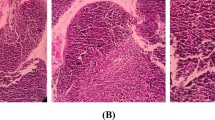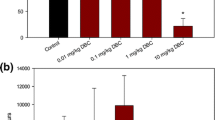Abstract
Benzene is a known contaminant found in trace amounts in ground water. It has long been associated with myelotoxicity and associated immunologic effects. The present study concerned the immunotoxic potential of benzene following four weeks of continuous oral administration via drinking water at concentrations of 0, 31, 166 and 790 mg/L. Benzene-treated water produced a dose-related decrease in spleen weight and increase in kidney weight; both were significantly different at the highest level. Benzene exposure caused a significant dose-response reduction of peripheral blood leukocytes, lymphocytes, erythrocytes and resulted in a severe macrocytic anemia. Splenic lymphocyte proliferation to both B cell and T cell mitogens [lipopolysaccharide (LPS), pokeweed mitogen (PWM), concanavalin A (Con A) and phytohemagglutinin (PHA)] was followed by a dose-related biphasic responsiveness, enhanced at the lowest dose (31 mg/L) and depressed in the higher dosage groups (166 and 790 mg/L). Cell-mediated immunity as measured by mixed-lymphocyte culture (MLC) response to allogeneic cells and cytotoxic T lymphocyte (CTL) activity to YAC-1 tumor ceils exhibited similar biphasic phenomenon. Antibody production as assessed by enumeration of the sheep red blood cell (SRBC)-specific plaque-forming cells (PFC) indicated a significant suppression of PFC in animals exposed to 166 and 790 mg/L benzene. A decrease in the α-SRBC-antibody titer corresponded to the numbers of PFC. The findings suggest that oral ingestion of benzene, at the concentrations utilized, produced a biologically significant immunotoxic effect on both the humoral and cellular immune responses.
Similar content being viewed by others
References
Aoyama K (1986) Effects of benzene inhalation on lymphocyte subpopulations and immune response in mice. Toxicol Appl Pharmacol 85:92–101
Aranyi C, O'Shea WJ, Graham JA, Miller JF (1986) The effects of inhalation of organic chemical air contaminants on murine lung host defenses. Fundam Appl Toxicol 6:713–720
Baarson KA, Snyder CA, Albert RE (1984) Repeated exposure of C57B1 mice to inhaled benzene at 10 ppm markedly depressed erythropoietic colony. Toxicol Lett 20:337–342
Bick H, Holsapple MP, White KL (1985) Assessment of the effects of chemicals on the immune system. In: Li AP (ed) New Approaches in Toxicity Testing and Their Application in Human Risk Assessment. Raven Press, New York, pp 165–177
Bolcsak LE, Nerland DE (1983) Inhibition of erythropoiesis by benzene metabolites. Toxicol Appl Pharmacol 69:363–368
Brief RS, Lynch J, Bereath T, Scala RA (1980) Benzene in the workplace. Am Ind Hyg Assoc J 43:616–623
Cunningham AJ, Szenberg A (1968) Further improvements in the plaque technique for detecting single antibody producing cells. Immunology 14:599–601
Dean BJ (1985) Recent findings on the genetic toxicology of benzene, toluene, xylenes, and phenols. Mutation Res 154:153–181
Dean JH, Luster MI, Boorman GA, and Lauer LD (1982) Procedures available to examine the immunotoxicity of chemicals and drugs. Pharmacol Rev 34:137–151
Dempster AM, Evans HL, Snyder CA (1984) The temporal relationship between behavioral and hematological effects of inhaled benzene. Toxicol Appl Pharmacol 76:195–203
Dinarello CA, Mier JW (1986) Interleukins. Ann Rev Med 37:173–178
Dowdy S, Wearden S (1983) Statistics for research. John Wiley & Sons, New York
Faith RE, Luster MI, Vos JG (1980) Effects on immunocompetence by chemicals of environmental concern. Ann Rev Biochem Toxicol 2:173–211
Fishbein I (1984) An overview of environmental and toxicological aspects of aromatic hydrocarbons. 1. Benzene. Sci Total Environ 40:189–218
Gaido K, Wierda D (1984)In vitro effects of benzene metabolites on mouse bone marrow stomal cells. Toxicol Appl Pharmacol 76:45–55
Garnett HM, Cronkite EP, Drew RT (1983) Effect ofin vivo exposure to benzene on the characteristics of bone marrow adherent cells. Leukemia Res 7:803–810
Grabstein K (1980) Cell-mediated cytolytic responses. In: Mishell BB, Shiigi SM (eds) Selected Methods in Cellular Immunology. WH Freeman, San Francisco, pp 124–137
Green JD, Snyder CA, LoBue J, Goldstein BD, Albert RE (1981) Acute and chronic dose/response effects of benzene inhalation on the peripheral blood, bone marrow, and spleen cells of CD-1 male mice. Toxicol Appl Pharmacol 59:204–214
Greenlee WF, Sun JD, Bus JS (1981) A proposed mechanism of benzene toxicity. Formation of reactive intermediates from polyphenol metabolites. Toxicol Appl Pharmacol. 59:187–195
Haley, T (1977) Evaluation of the health effects of benzene inhalation. Clin Toxicol 11:531–548
Hanahan DJ, Ekholm JE (1974) The preparation of red cell ghosts (membranes). Methods Enzymol XXXI: 168–172
Harigaya K, Miller ME, Cronkite EP, Driw RT (1981) The detection ofin vivo hematoxicity of benzene byin vitro liquid bone marrow cultures. Toxicol Appl Pharmacol 60:346–353
Irons RD (1985) Quinones as toxic metabolites of benzene. J Toxicol Environ Hlth 16:673–678
Jerne NK, Nordin AA (1963) Plaque formation in agar by single antibody-producing cells. Science 140:405–407
Kaplan HS (1967) On the natural history of the murine leukemias. Cancer Res 27:1325–1340
Longacre SL, Kocsis JJ, Snyder R (1981) Influence of strain differences in mice on the metabolism and toxicity of benzeae. Toxicol Appl Pharmacol 60:398–409
Moszczynsky P, Lisiewicz J (1984) Occupational exposure to benzene, toluene and xylene and the T lymphocyte functions. Haematologia 17:449–453
Pandya KP, Shanker R, Gupta A, Khan WA, Ray PK (1986) Modulation of benzene toxicity by an interferon inducer (GMFA). Toxicology 39:291–305
Pfeifer RW, Irons RD (1982) Effect of benzene metabolites on phytohemagglutinin-stimulated lymphopoiesis in rat bone marrow. J Reticuloendothel Soc 31:155–170
Post GB, Snyder R, Kalf GF (1985) Inhibition of RNA synthesis and interleukin-2 production in lymphocytesin vitro by benzene and its metabolites, hydroquinone, andp-benzoquinone. Toxicol Lett 29:161–168
Rosenthal GJ, Snyder CA (1985) Modulation of the immune response toListeria monocytogenes by benzene inhalation. Toxicol Appl Pharmacol 80:502–510
Rozen MG, Snyder CA (1985) Protracted exposure of C57B1/6 mice to 300 ppm benzene depresses B- and T-lymphocyte numbers and mitogen responses. Evidence for thymic and bone marrow proliferation in response to the exposures. Toxicology 37:13–26
Rozen MG, Snyder CA, Albert RE (1984) Depression in B- and T-lymphocyte mitogen-induced blastogenesis in mice exposed to low concentrations of benzene. Toxicol Lett 20:343–349
Sawahata T, Rickert DE, Greenlees WE (1985) Metabolism of benzene and its metabolites in bone marrow. In: Irons RD (ed) Toxicology of the Blood and Bone Marrow. Raven Press, New York, pp 141–148
Schwartz CS, Snyder R, Kalf GF (1985) The inhibition of mitochondrial DNA replicationin vitro by the metabolites of benzene, hydroquinone andp-benzoquinone. Chem Biol Interac 53:327–350
Sharma RP, Gehring PJ (1979) Immunologic effects of vinyl chloride in mice. Ann NY Acad Sci 320:551–563
Snyder CA, Goldstein BD, Sellakumar A, Bromberg I, Laskin S, Albert RE (1982) Toxicity of chronic benzene inhalation: CD-1 mice exposed to 300 ppm. Bull Environ Contam Toxicol 29:385–391
— (1980) The inhalation toxicology of benzene: Incidence of hematopoietic neoplasms and hematotoxicity in ARK/J and C57BL/6J mice. Toxicol Appl Pharmacol 54:323–331
US Environmental Protection Agency (1980) Ambient Water Quality Criteria for Benzene. (EPA 440/5-80-018). Washington, DC
- (1982) Test Methods for Evaluating Solid Waste. Physical/Chemical Methods. 2nd Edition. Office of Solid Waste and Emergency Response. SW-846. Washington, DC
Voller A, Bidwell DE, Bartlett A (1979) The enzyme linked immunosorbent assay (ELISA). A guide with abstracts of microplate applications. Dynatech Laboratories, Alexandria, VA
Walker PP, Walker JK, Evans HH, Blumer JL (1985) Relationship between the oxidation potential of benzene metabolites and their inhibitory effect of DNA synthesis on L5178YS cells. Molec Pharmacol 28:560–566
Wierda D, Irons RD (1982) Hydroquinone and catechol reduce the frequency of progenitor B-lymphocytes in mouse spleen and bone marrow. Immunopharmacology 4:41–54
Wierda D, Irons RD, Greenlee WF (1981) Immunotoxicity in C57BL/6 mice exposed to benzene and Aroclor 1254®. Toxicol Appl Pharmacol 60:410–417
Author information
Authors and Affiliations
Rights and permissions
About this article
Cite this article
Hsieh, G.C., Sharma, R.P. & Parker, R.D.R. Subclinical effects of groundwater contaminants I: Alteration of and cellular immunity by benzene in CD-1 mice. Arch. Environ. Contam. Toxicol. 17, 151–158 (1988). https://doi.org/10.1007/BF01056019
Received:
Revised:
Issue Date:
DOI: https://doi.org/10.1007/BF01056019




